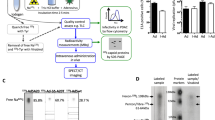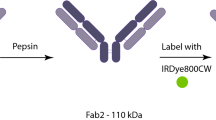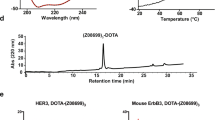Abstract
A model epitope-tagged receptor was constructed by fusing the hemagglutinin (HA) sequence on the extracellular N-terminus of the human somatostatin receptor subtype 2 (hSSTr2) gene. This construct was placed in an adenoviral (Ad-HAhSSTr2) vector. This study evaluated Ad-HAhSSTr2 in vitro and in vivo using FACS, fluorescent microscopy, radioactive binding assays, and gamma camera imaging techniques. Infection of A-427 non-small cell lung cancer cells with Ad-HAhSSTr2 or Ad-hSSTr2 resulted in similar expression of hSSTr2 by FACS analysis and binding assays using a 99mTc-labeled somatostatin analogue (99mTc-P2045). HAhSSTr2 expression in A-427 cells was specific for infection with Ad-HAhSSTr2. FITC-labeled anti-HA antibody (FITC-HA) confirmed surface expression in live A-427 cells and the absence of internalization. Gamma camera imaging and gamma counter analysis of normal mice showed significantly greater (P<0.05) liver uptake of 99mTc-labeled anti-HA antibody (99mTc-anti-HA) in mice injected i.v. 48 h earlier with Ad-HAhSSTr2 (53.6±6.9% ID/g) as compared to mice similarly injected with Ad-hSSTr2 (9.0±1.3% ID/g). In a mouse tumor model, imaging detected increased tumor localization of 99mTc-anti-HA due to direct intratumor injection Ad-HAhSSTr2. Gamma counter analysis confirmed significantly greater (P<0.05) uptake of 99mTc-anti-HA in tumors injected with Ad-HAhSSTr2 (12.5±4.1% ID/g) as compared to Ad-hSSTr2-infected tumors (5.1±1.5% ID/g). These studies demonstrate the feasibility of using an epitope-tagged reporter receptor for non-invasively imaging gene transfer.
This is a preview of subscription content, access via your institution
Access options
Subscribe to this journal
Receive 12 print issues and online access
$259.00 per year
only $21.58 per issue
Buy this article
- Purchase on Springer Link
- Instant access to full article PDF
Prices may be subject to local taxes which are calculated during checkout







Similar content being viewed by others
References
Human gene marker/therapy clinical protocols (complete updated listings). Hum Gene Ther 1999; 10: 3067–3123.
Contag CH, Jenkins D, Contag PR, Negrin RS . Use of reporter genes for optical measurements of neoplastic disease in vivo. Neoplasia 2000; 2: 41–52.
Lipshutz GS et al. In utero delivery of adeno-associated viral vectors: intraperitoneal gene transfer produces long-term expression. Mol Ther 2001; 3: 284–292.
Yang M et al. Visualizing gene expression by whole-body fluorescence imaging. Proc Natl Acad Sci USA 2000; 97: 12 278–12 282.
Pfeifer A et al. Transduction of liver cells by lentiviral vectors: analysis in living animals by fluorescence imaging. Mol Ther 2001; 3: 319–322.
Chaudhuri TR et al. Light-based imaging of green fluorescent protein-positive ovarian cancer xenografts during therapy. Gynecol Oncol 2001; 82: 581–589.
Chaudhuri TR et al. A noninvasive reporter system to image adenoviral-mediated gene transfer to ovarian cancer xenografts. Gynecologic Oncol 2001; 83: 432–438.
Weissleder R et al. In vivo magnetic resonance imaging of transgene expression. Nat Med 2000; 6: 351–355.
Louie AY et al. In vivo visualization of gene expression using magnetic resonance imaging. Nat Biotechnol 2000; 18: 321–325.
Stegman LD et al. Noninvasive quantitation of cytosine deaminase transgene expression in human tumor xenografts with in vivo magnetic resonance spectroscopy. Proc Natl Acad Sci USA 1999; 96: 9821–9826.
Walter G, Barton ER, Sweeney HL . Noninvasive measurement of gene expression in skeletal muscle. Proc Natl Acad Sci USA 2000; 97: 5151–5155.
Auricchio A, Zhou R, Wilson JM, Glickson JD . In vivo detection of gene expression in liver by 31P nuclear magnetic resonance spectroscopy employing creatine kinase as a marker gene. Proc Natl Acad Sci USA 2001; 98: 5205–5210.
Gambhir SS et al. Imaging of adenoviral-directed herpes simplex virus type 1 thymidine kinase reporter gene expression in mice with radiolabeled ganciclovir. J Nucl Med 1998; 39: 2003–2011.
Tjuvajev JG et al. A general approach to the non-invasive imaging of transgenes using cis- linked herpes simplex virus thymidine kinase. Neoplasia 1999; 1: 315–320.
Tjuvajev JG et al. Imaging adenoviral-mediated herpes virus thymidine kinase gene transfer and expression in vivo. Cancer Res 1999; 59: 5186–5193.
Hospers GA et al. Monitoring of herpes simplex virus thymidine kinase enzyme activity using positron emission tomography. Cancer Res 2000; 60: 1488–1491.
Gambhir SS et al. A mutant herpes simplex virus type 1 thymidine kinase reporter gene shows improved sensitivity for imaging reporter gene expression with positron emission tomography. Proc Natl Acad Sci USA 2000; 97: 2785–2790.
Gambhir SS, et al. Imaging transgene expression with radionuclide imaging technologies. Neoplasia 2000; 2: 118–138.
Iyer M et al. 8-18Ffluoropenciclovir: an improved reporter probe for imaging HSV1-tk reporter gene expression in vivo using PET. J Nucl Med 2001; 42: 96–105.
Hustinx R et al. Imaging in vivo herpes simplex virus thymidine kinase gene transfer to tumour-bearing rodents using positron emission tomography and[18F]FHPG. Eur J Nucl Med 2001; 28: 5–12.
Jacobs A et al. Positron emission tomography-based imaging of transgene expression mediated by replication-conditional, oncolytic herpes simplex virus type 1 mutant vectors in vivo. Cancer Res 2001; 61: 2983–2995.
MacLaren DC et al. Repetitive, non-invasive imaging of the dopamine D2 receptor as a reporter gene in living animals. Gene Ther 1999; 6: 785–791.
Liang Q et al. Noninvasive, quantitative imaging in living animals of a mutant dopamine D2 receptor reporter gene in which ligand binding is uncoupled from signal transduction. Gene Ther 2001; 8: 1490–1498.
Zinn KR et al. Noninvasive monitoring of gene transfer using a reporter receptor imaged with a high affinity peptide radiolabeled with 99mTc or 188Re. J Nucl Med 2000; 41: 887–895.
Rogers BE, Zinn KR, Buchsbaum DJ . Gene transfer strategies for improving radiolabeled peptide imaging and therapy. Q J Nucl Med 2000; 44: 208–223.
Zinn KR et al. Gamma camera dual imaging with a somatostatin receptor and thymidine kinase after gene transfer with a bicistronic adenovirus in mice. Radiology 2002; 223: 417–425.
Yu Y et al. Quantification of target gene expression by imaging reporter gene expression in living animals. Nat Med 2000; 6: 933–937.
Boland A et al. Adenovirus-mediated transfer of the thyroid sodium/iodide symporter gene into tumors for a targeted radiotherapy. Cancer Res 2000; 60: 3484–3492.
Raben D et al. Enhancement of radiolabeled antibody binding and tumor localization through adenoviral transduction of the human carcinoembryonic antigen gene. Gene Ther 1996; 3: 567–580.
Zinn KR et al. Simultaneous evaluation of dual gene transfer to adherent cells by gamma-ray imaging. Nucl Med Biol 2001; 28: 135–144.
Koller KJ et al. A genetic method for the production of cell lines expressing high levels of 7-transmembrane receptors. Anal Biochem 1997; 250: 51–60.
Kundra V, Mannting F, Jones AG, Kassis AI . Noninvasive monitoring of somatostatin receptor subtype 2 chimeric gene transfer. J Nucl Med 2002; 43: 406–412.
Zinn KR et al. Detection and measurement of in vitro gene transfer by gamma camera imaging. Gene Ther 2001; 8: 291–299.
Andersson P et al. Internalization of indium-111 into human neuroendocrine tumor cells after incubation with indium-111-DTPA-D-Phe1-octreotide. J Nucl Med 1996; 37: 2002–2006.
de Jong M et al. Comparison of 111In-labeled somatostatin analogues for tumor scintigraphy and radionuclide therapy. Cancer Res 1998; 58: 437–441.
van der Eb MM et al. Severe hepatic dysfunction after adenovirus-mediated transfer of the herpes simplex virus thymidine kinase gene and ganciclovir administration. Gene Ther 1998; 5: 451–458.
Alemany R, Curiel DT . CAR-binding ablation does not change biodistribution and toxicity of adenoviral vectors. Gene Ther 2001; 8: 1347–1353.
Zinn KR et al. Imaging and tissue biodistribution of 99mTc-labeled adenovirus knob (serotype 5). Gene Ther 1998; 5: 798–808.
Haunschild J, Haro HP, Pack P, Pluckthun A . Pharacokinetic properties of bivalent miniantibodies and comparison to other immunoglobulin forms. Antib Immunoconjugates Radiopharm 1995; 8: 111–128.
Slavin-Chiorini DC et al. A CDR-grafted (humanized) domain-deleted antitumor antibody. Cancer Biother Radiopharm 1997; 12: 305–316.
Wu AM et al. High-resolution microPET imaging of carcinoembryonic antigen-positive xenografts by using a copper-64-labeled engineered antibody fragment. Proc Natl Acad Sci USA 2000; 97: 8495–8500.
Bousquet C et al. Antiproliferative effect of somatostatin and analogs. Chemotherapy 2001; 47: 30–39.
Ferjoux G et al. Signal transduction of somatostatin receptors negatively controlling cell proliferation. J Physiol Paris 2000; 94: 205–210.
Rochaix P et al. Gene therapy for pancreatic carcinoma: local and distant antitumor effects after somatostatin receptor sst2 gene transfer. Hum Gene Ther 1999; 10: 995–1008.
Fitzpatrick VD, Vandlen RL . Agonist selectivity determinants in somatostatin receptor subtypes I and II. J Biol Chem 1994; 269: 24 621–24 626.
Kaupmann K et al. Two amino acids, located in transmembrane domains VI and VII, determine the selectivity of the peptide agonist SMS 201-995 for the SSTR2 somatostatin receptor. EMBO J 1995; 14: 727–735.
Liapakis G et al. Identification of ligand binding determinants in the somatostatin receptor subtypes 1 and 2. J Biol Chem 1996; 271: 20 331–20 339.
Strnad J, Hadcock JR . Identification of a critical aspartate residue in transmembrane domain three necessary for the binding of somatostatin to the somatostatin receptor SSTR2. Biochem Biophys Res Commun 1995; 3: 913–921.
Nehring RB, Meyerhof W, Richter D . Aspartic acid residue 124 in the third transmembrane domain of the somatostain receptor subtype 3 is essential for somatostatin-14 binding. DNA Cell Biol 1995; 14: 939–944.
Roth A et al. Endocytosis of the rat sinatistin receptors: subtype discrimination, ligand specificity, and delineation of carboxy-terminal positive and negative sequence motifs. DNA Cell Biol 1997; 16: 111–119.
Koenig JA et al. Fates of endocytosed somatostatin sst2 receptors and associated agonists. Biochem J 1998; 336: 291–298.
Bogadanov JA, Petherick P, Marecos E, Weissleder R . In vivo localization of diglycylcysteine-bearing synthetic peptides by nuclear imaging of oxotechnetate transchelation. Nucl Med Biol 1997; 24: 739–742.
He T et al. A simplified system for generating recombinant adenoviruses. Proc Natl Acad Sci USA 1998; 95: 2509–2514.
Rogers BE et al. In vivo localization of 111In-DTPA-D-Phe1-octreotide to human ovarian tumor xenografts induced to express the somatostatin receptor subtype 2 using an adenoviral vector. Clin Cancer Res 1999; 5: 383–393.
Zinn KR et al. Imaging Tc-99m-labeled FGF-1 targeting in rats. Nucl Med Biol 2000; 27: 407–414.
Acknowledgements
This work was supported by the NIH grant CA80104 and grants from the Avon Products Foundation and the American Heart Association. The authors appreciate the generous supply of P2045 from Diatide Research Laboratories (Londonberry, NH, USA). The authors thank Sheila Bright, Ashley Davis, Charlotte Hammond, Synethia Kidd, Richard Kirkman, Gloria Robinson, and Leisa Seay for excellent technical assistance.
Author information
Authors and Affiliations
Rights and permissions
About this article
Cite this article
Rogers, B., Chaudhuri, T., Reynolds, P. et al. Non-invasive gamma camera imaging of gene transfer using an adenoviral vector encoding an epitope-tagged receptor as a reporter. Gene Ther 10, 105–114 (2003). https://doi.org/10.1038/sj.gt.3301853
Received:
Accepted:
Published:
Issue Date:
DOI: https://doi.org/10.1038/sj.gt.3301853
Keywords
This article is cited by
-
Adenoviral-mediated imaging of gene transfer using a somatostatin receptor-cytosine deaminase fusion protein
Cancer Gene Therapy (2015)
-
Radiolabeling Strategies for Radionuclide Imaging of Stem Cells
Stem Cell Reviews and Reports (2015)
-
Imaging of Cells and Nanoparticles: Implications for Drug Delivery to the Brain
Pharmaceutical Research (2012)
-
Noninvasive cell-tracking methods
Nature Reviews Clinical Oncology (2011)
-
Cell Tracking
Der Radiologe (2007)



